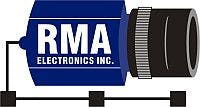Machine vision and imaging distributor spotlight: RMA Electronics, Inc.
To provide our readers with much information onhow to obtain the right technology for their application as possible, we are profiling major machine vision and image processing distributors from across the globe.
In this article, Ron Massa Jr., President of RMA Electronics, Inc. (pictured), provides some information on his company’s services, and provides his take on the rise of non-industrial imaging and the overall state of themachine vision industry, while also providing a take on some imaging products that could be popular in the near future.
Company name:RMA Electronics, Inc.
Headquarters: Hingham, MA, USA
Year founded: 1986
Regions served: Global distribution
Products carried:Industrial video products - CCTV/machine vision lenses, industrial video cameras, video capture boards, machine vision and recording software, optical filters, cables, and monitors.
Companies carried:
Lenses:Kowa, Fujinon, Computar (CBC Americas Corp.), Ricoh, Schneider Optics, Tamron, Goyo Optical, Theia Technologies, Navitar, Azure Photonics, Senko ADL, Yamano Optical, and VS Technology.
Cameras: Allied Vision, Hitachi, Sentech, Sony, Imperx, and Ikegami
Video Capture Boards: Euresys and Imperx
Optical Filters: Midwest Optical Systems
Cables: Intercon 1 (Nortech Systems)
Monitors: Orion Images, Ganz (CBC Americas Corp.)
How have market changes and customer demands changed the way that you’ve approached business?
Overall, customers seem to be more knowledgeable today about these technologies than they were five years ago, for example. They seem to know what they want more often, or at least have a general idea.
Many of these products have also become commoditized. The result of these changes for us has resulted in more eCommerce-based business and less time having to educate customers. We believe strongly in providing outstanding customer service as a way of differentiating us from our competitors.
In what areas do you see the most growth?
We have seen growth in non-traditional machine vision applications such as sports/broadcast, entertainment, autonomous vehicles, aerial mapping, and tracking/analytics. More and more we are selling various industrial video equipment to customers who are using it in some other way than a traditional inspection application.
What is your take on the current state of the machine vision market?
Overall I would characterize it as strong, when we factor in these non-traditional types of applications. We sell worldwide, so often when there is a slow-down in a certain country or region, we might also see upticks in business from other regions of the world.
Is there a particular trend or product in the next few years that you see as “the next big thing?”
That would be hard to say from our perspective. What I do see is that the lens manufacturers are starting to do a better job addressing needs for products to meet the new cameras (sensors) that have been introduced to the market. An example would be larger format, multi-megapixel lenses for small pixel pitch sensors. For years it has always seemed like a game of playing “catch-up” from the lens manufacturers’ perspective to the camera guys.
For a specific technology, I believe P-Iris will become more main stream, even in machine vision (where light level environments is often controlled). We see it in ITS/traffic and high-end video surveillance certainly, but the P-Iris technology could be well-suited for some of these non-traditional machine vision applications discussed earlier—specially for the benefit of providing better (larger) depth of field.
What camera type do you think will be most popular in two years and why?
From customers we work with, I believe GigE will still be the dominant digital camera interface two years from now. Many USB 3.0 camera users we talk with say it is still too unstable – especially for multi-camera systems.
What is the best way for customers to get in touch with you?
E-mail:[email protected]
Tel: +1- 781-749-9700
“We will respond quickly, as it is part of our strong believe in outstanding customer service,” said Massa.
View more information onRMA Electronics Inc.
Share your vision-related news by contactingJames Carroll, Senior Web Editor, Vision Systems Design
To receive news like this in your inbox,click here
Join ourLinkedIn group | Like us on Facebook | Follow us on Twitter| Check us out on Google +
About the Author

James Carroll
Former VSD Editor James Carroll joined the team 2013. Carroll covered machine vision and imaging from numerous angles, including application stories, industry news, market updates, and new products. In addition to writing and editing articles, Carroll managed the Innovators Awards program and webcasts.

